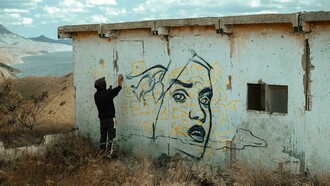During the end of October and beginning of November, the National Museum of Mexican Art in Chicago houses their annual exhibition that displays the Mexican legend of Mictlán, the underworld of the Mexican culture that opens its doors for the return of souls, known as Día de Muertos or Day of the Dead.
The Second gallery of the museum’s exhibition focuses on how Day of the Dead is commemorated in different regions of Mexico. Cesareo Moreno, curator of the museum shares his insights from a curator’s point of view about their current temporary exhibition Día de Muertos, Memories & Offerings.
The Day of the Dead is an interesting cultural and religious holiday celebrated throughout Mexico on November 1 and 2. These dates coincide with the Catholic holiday called All Saints’ Day and All Souls’ Day. It is believed that the gates of heaven are opened at midnight on October 31, and the spirits of all the departed children (Angelitos) are allowed to reunite with their families for 24 hours. On November 2, the spirits of the adults come down to enjoy the festivities that are prepared for them. Reflecting on your experience over the years as a curator. What articulates your vision and approach to Dia de Muertos exhibition making?
Cesareo Moreno: When looking for novel ways to present Día de muerto expressions at the NMMA/Museum, I often look to the traditional artists and the folk art produced in various regions of Mexico. Each year artists in the U.S. will also create works of art that incorporate this ancient celebration of life, remembrance, and for them, Mexican identity. For me as a curator, it is an annual surprise to uncover the common threads on both sides of the border, from small villages in Michoacán to big cities like LA. The uniqueness of a regional celebration is frequently embedded in the far spread Mexican culture – in the Mexicanidad (Mexicanness) that exists throughout North America, regardless if the language spoken is Spanish, Mayan, Nahuatl, or English.
Considering the design and display tactics, didactic materials, and your overall experience. Is your current exhibition about Dia de Muertos/Day of the Dead successfully communicating your curatorial idea? Can the audience fully understand and experience the artwork that represents how the indigenous people of Mexico have combined their own ancient beliefs of honoring their deceased loved ones?
Cesareo Moreno: I believe each person is capable of a unique amount of understanding and appreciation in the exhibition. Death, grief and remembrance of loved ones are deeply personal human approaches that are shaped by age, experience and one’s own culture. The works of art and the support materials such as infographics and gallery chats, can only encourage visitors to consider the inevitable fate that awaits us all – The universal fact of humanity. The exhibition displays can only come close to the experience of an actual Día de muertos celebrations that take place in Mexican homes and cemeteries on a given week in November... The works of art and the imagery in a museum setting are lacking the music and words, the smells and the tastes of the actual communal celebration of a shared life and culture. Our exhibition points to the soul of a Día de muertos celebration and hopefully gives our visitors an idea of what happens in Mexican communities.
Participation is crucial in putting together an exhibition. Curators and the artists have to work as a team on the curation and organization of an exhibition. What are some of the challenges as a curator do you experience?
Cesareo Moreno: A big challenge usually seems to be working with non-artists, with individuals who do not have experience creating visual works and so do not “speak” the same language that artists, curators and preparators understand. Their creations typically revolve around an intense love for someone who has passed away, and a desire to tell a heartfelt story. It is then the role of the curators and the preparators to help visualize the narrative in a way that is aesthetic, authentic and fulfills a family’s intensions. The museum explains what is possible and then closely follows the family as they create the most fitting tribute for their deceased loved one.
Mexican artists use a Cartonería technique, can you elaborate?
Cesareo Moreno: Cartonería is a technique of shaping cardboard and papier-mâché with engrudo (wheat paste) to create colorful figures and scenes. There are numerous Mexican artisans who use the technique to create decorative works, playthings or ephemeral folk art for festivals. Contemporary artists use this traditional medium to create one of a kind works of art.
Can you explain the meaning behind the edible or decorative sugar skulls that are used in the Mexican celebration of Day of the Dead? What do the skulls represent in Mexican culture?
Cesareo Moreno: Calaveras de azúcar (sugar skulls) are a lighthearted element to many Day of the Dead celebrations in Central Mexico. This practice of molding skulls out of alfeñique (a confection made of cane sugar) dates back to the colonial period. Often placed on altars as offerings, the sugar skulls can symbolize a departed loved one that will return on All Souls’ Day.
The exhibition features a cartonería skeletal scene by Paula García de Linares (b.1951) which depicts the final step in making sugar skulls. After they have cooled and been removed from the ceramic molds, the sweet skulls are then decorated with scroll icing and metallic foils.
Muertos, Memories & Offerings is a wonderful exhibition. What do you hope visitors can learn from this important cultural experience?
Cesareo Moreno: Día de Muertos is a beautiful celebration from Mexico, a celebration of life that everyone can adopt. It is a helpful, healing way to grieve. You don’t have to be Mexican, you don’t have to be religious, it doesn’t have to be about art. It’s just a great way to remember those who are no longer physically with us. We talk about them, we say their names, we teach their stories and keep their memories alive.















